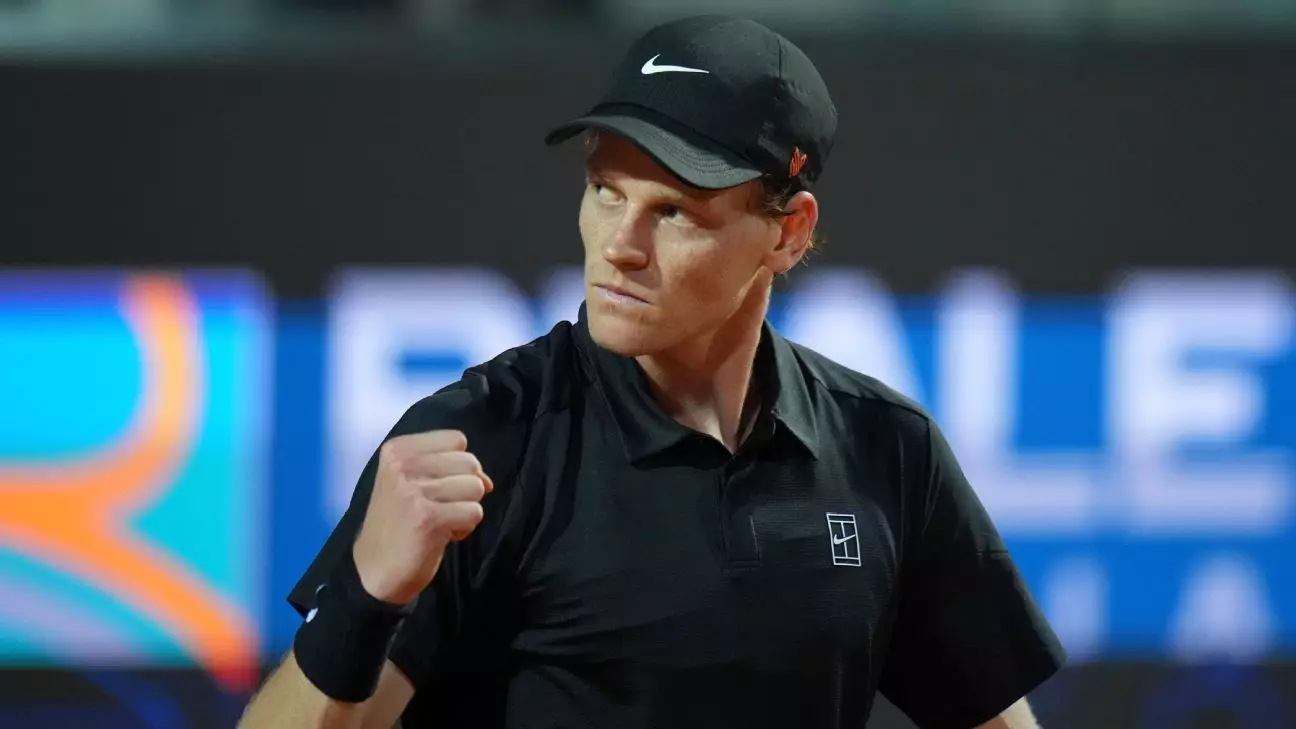Jannik Sinner’s return to the tennis world after a three-month doping ban is more than a simple comeback; it is a testament to the player’s resilience and competitive spirit. His victory against Mariano Navone at the Italian Open is not just significant because he won, but it encapsulates the intricate dynamics of a young athlete overcoming adversity. For Sinner, stepping back on the court after such a lengthy hiatus posed not only a physical challenge but also a mental one, as doubts crept in leading up to his first match since the Australian Open.
As he faced the 99th-ranked Navone, Sinner banished any residual anxieties with a confident performance that saw him clinch the match 6-3, 6-4. The joy radiating from him after the match exemplified both relief and jubilance, a narrative that every sports fan could resonate with. “Amazing feeling,” he expressed, emphasizing how long he had anticipated this moment. His journey has provided a compelling storyline within the competitive tennis landscape, making his return a moment to treasure, not just for him but for his fans.
The Weight of Doubt
Doubt, as Sinner acknowledged, is an inherent part of being an athlete. His admission that the uncertainty of his form weighed on him shows a level of vulnerability that many sports figures often conceal. Sinner’s candor around his doubts reflects a maturing mindset, understanding that facing internal conflict is integral to personal growth and competitive success. “It’s normal to have doubts,” he noted, signaling a healthy acceptance of the psychological aspect of sport, which often gets glossed over in favor of sheer talent and results.
The mental battle is equally as crucial as the physical aspect, particularly in a sport as isolating and intense as tennis. Sinner’s capacity to confront his insecurities augurs well for his future endeavors. By recognizing that these thoughts stem from a passion to improve, he redefines the narrative of doubt from a crippling force to a motivating flame for his career.
The Power of Home Advantage
The compelling atmosphere during Sinner’s match was palpable, a dynamic amplified by the fervor of the home crowd at the Foro Italico. The sold-out arena, decked in orange, Sinner’s signature color, showcased a unique aspect of sports—the electric connection between an athlete and their supporters. The crowd, echoing chants of “Ole, ole, ole, Sin-ner, Sin-ner,” transformed the match into a festival of tennis, providing Sinner with the emotional fuel necessary to regain his competitive edge.
The camaraderie between Sinner and his fans underscores the importance of community support in sports. His presence galvanized the crowd, evolving their collective anticipation into palpable energy on the court. This mutual encouragement is a core component of Sinner’s comeback story, revealing that while raw talent is vital, the backing of a vibrant network can propel an athlete beyond their limits.
The Controversial Backstory
Despite the celebratory mood, Sinner’s return is not devoid of controversy. The circumstances surrounding his doping ban raised eyebrows among audiences and fellow competitors alike. Critics suggest that some aspects of the punishment—specifically the timing—were too lenient, allowing him to emerge unscathed from the Grand Slam season. Such scrutiny adds layers to the narrative of his return, transforming a triumphant comeback into a subject of debate about fairness and discipline within the sport.
Sinner’s situation emphasizes the complexities at play in professional sports, where off-court issues often redefine public perception. It raises compelling questions about how an athlete’s journey should be viewed—talent versus hard work, or reputation versus results. This multifaceted dialogue will likely follow Sinner throughout his career, illuminating the intricacies of an athlete’s life beyond what is seen on the court.
Future Aspirations
Moving forward, Sinner’s ambition to continue competing and winning on the home soil is unmistakable. With his sights set on the upcoming matches, he spoke of the desire to gauge his progress and find out exactly where he stands as an athlete. The hope of playing additional matches at the Italian Open is not merely a goal but also a strategic move to reestablish rhythm and confidence in his game. As he prepares to face the 93rd-ranked Jesper De Jong, Sinner’s outlook remains focused yet determined.
The Italian Open serves as a pivotal stage for Sinner to affirm his status, not just as a returning player, but as a serious contender in the tennis world. With a winning streak of 22 matches dating back to October, expectations run high, but so too does the potential for greatness. Sinner embodies a new generation of tennis talent, flexible in his approach to challenges and relentless in his pursuit of victory. This narrative of evolution and triumph will undoubtedly inspire not only his supporters but also resonate with aspiring athletes everywhere.


Leave a Reply